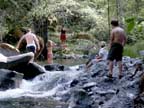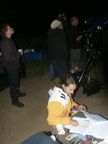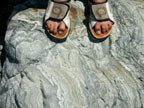Astro 28J: Field Astronomy
to Observe Comet Hartley 2
Oct 8-10, 2010
Post-Trip Photo Page
We'll journey to a choice location
with dark skies to observe the close approach of Comet Hartley to the Earth
in early October. Comet Hartley is a short-period comet, heavily modified by
repeated passages by the sun. It's appearance may resemble that of Comet Holmes
in 2008, or it may (as comets are likely to do) completely surprise us with
its brightness, behavior, and color. The dust content of short-period comets
is higher, often making for a distinct double tail of gas and dust forking in
different directions.
 Comet
Hartley will move rapidly across Perseus in mid October,
passing near the famous Double Cluster during our weekend. The comet
will make the closest
approach to Earth that it has ever made, passing only
11 million miles away in early October (that's 1/10 the Earth-Sun distance).
Photographing a comet in the Milky Way could make for some very nice
pictures. The comet is predicted to be 5th magnitude, a nice binocular
object. The comet has a small but active nucleus and is a prime interest
for cometary astronomers. Just one day after our weekend trip ends,
NASA 's Deep Impact spacecraft, part of the EPOXI mission will pass
by the comet to take samples and data to study, and so our obseravations
will be a valuable addition to characterizing the comet prior to rendezvous.
Comet
Hartley will move rapidly across Perseus in mid October,
passing near the famous Double Cluster during our weekend. The comet
will make the closest
approach to Earth that it has ever made, passing only
11 million miles away in early October (that's 1/10 the Earth-Sun distance).
Photographing a comet in the Milky Way could make for some very nice
pictures. The comet is predicted to be 5th magnitude, a nice binocular
object. The comet has a small but active nucleus and is a prime interest
for cometary astronomers. Just one day after our weekend trip ends,
NASA 's Deep Impact spacecraft, part of the EPOXI mission will pass
by the comet to take samples and data to study, and so our obseravations
will be a valuable addition to characterizing the comet prior to rendezvous.
Course Location: The
first winter storm has temporarily closed the road over 9,100 ft Kaiser Pass
to get to Mono Hot Springs. While the snow is not deep, continuing snow showers
and the uncertainty of black ice (this road is never plowed) after dark has
forced me to change locations, for safety reasons. Also, an informal poll
among you has shown most supporting a change to Big Sur. There are other
advantages: Ponderosa campground has a better view of the sky with respect
to trees, it is only half the driving distance and expense. Our course will
now be conducted at Ponderosa Campground deep in the Big Sur Mountains west
of Fort Hunter-Liggett, on the Nacimiento River. During the day on Saturday,
we'll drive over the ridge and down the steep road, pausing for lectures
on the ancient subduction zone which gave rise to these dramatic mountains,
and the metamorphic rocks on the beaches below. We'll tie this into nature
of plate tectonics and relate to the other planets. In the evening, we'll
study the stars and galaxies of the Fall sky, and especially the brightening
Comet Hartley. We'll have a visiting professor - Chris Kitting from CSUEB -
who is an expert in astrophotography and will demonstrate comet photography
for us. I'll also be showing you the comet and other wonders in the telescope,
and do astrophotography in the late evening. On Sunday, I'll cook one of my
famous breakfasts, and then we'll have a lecture down on the river, examing
the rock types and enjoying the cool waters on this, predicted to be a hot
day inland. Here's the latest
weather forecast.

Studying metamorphics from the ancient abyssal plains below the ocean,
at Kirk Creek |
Banded metamorphic marble on
the beach |

The stream through the campground has some nice swimming holes...
|
...and will be a nice substitute for the hot springs, I expect. |

Comet Hartley
2 should be a fine green glow near the Double Cluster in Perseus |
Here's the photo pages for Astro
28L and for
Astro
28N. This too is a location we have used in past Astro 28's.
No hot springs, but two nice cool streams going through camp, good views
of the sky, and easier to drive to by far, and warmer night time temperatures,
and very different geology to explore.
Other Astronomical Highlights
Early October
is the ideal time to study the star fields and nebulae of the summer Milky Way
in the early evening sky. This is the region which contains the center of our
galaxy and is home to over 100 thousand million stars. The constellations of
Sagittarius, Scorpius, Aquila and Cygnus contain some of the finest deep sky
objects in the sky, strewn across the Sagittarius spiral arm of our galaxy about
5 kiloparsecs inside the sun's orbit around the Galaxy. We'll study the Eagle
Nebula, the Lagoon Nebula, the North America Nebula, the beautiful supernova
remnant known as the Veil Nebula, and a large collection of open star clusters
and globular star clusters. All of these objects I and my students have captured
in digital photographs which you can see here.
Planetary Science
 During
the day, we'll take short hikes to study the many and varied Mono Hot Springs
by a direct first-hand immersive experience! Doris Lake and the thermal springs
which feed it, study the granite domes and paint the story of the glaciations
which formed them, and have in-the-field lectures along the way. These lectures
will cover the structure of the inner planets of our solar system, what conditions
are needed in order for a planet to be geologically active, tectonic activity,
the geological history of California and the Sierra, and also rock types and
morphology.
During
the day, we'll take short hikes to study the many and varied Mono Hot Springs
by a direct first-hand immersive experience! Doris Lake and the thermal springs
which feed it, study the granite domes and paint the story of the glaciations
which formed them, and have in-the-field lectures along the way. These lectures
will cover the structure of the inner planets of our solar system, what conditions
are needed in order for a planet to be geologically active, tectonic activity,
the geological history of California and the Sierra, and also rock types and
morphology.
Course Grading
Your grades will be based on class
participation and enthusiasm, and also on your take-home final exam which you'll
mail in to me two weeks after our return. Take note - these classes are important
to me, and to the Astronomy program. It's important that I do everything I can
to encourage participation by good students who will be responsible. See "The Rules of the Game" linked web page for more on what's expected of you and how you will be graded. Also, a helpful attitude around the
group work loads, a willingness to listen to the lectures and participate in
the discussions, no swearing, and a strict adherence to the Cabrillo policy
of no drugs or alcohol, will all count in your favor. These classes are always a lot of fun - we blend learning
with enjoyment and this makes for the maximum educational impact... Join us!
Signing up for the
class
The Rules of the Game
Camper's Checklist
 Comet
Hartley will move rapidly across Perseus in mid October,
passing near the famous Double Cluster during our weekend. The comet
will make the closest
approach to Earth that it has ever made, passing only
11 million miles away in early October (that's 1/10 the Earth-Sun distance).
Photographing a comet in the Milky Way could make for some very nice
pictures. The comet is predicted to be 5th magnitude, a nice binocular
object. The comet has a small but active nucleus and is a prime interest
for cometary astronomers. Just one day after our weekend trip ends,
NASA 's Deep Impact spacecraft, part of the EPOXI mission will pass
by the comet to take samples and data to study, and so our obseravations
will be a valuable addition to characterizing the comet prior to rendezvous.
Comet
Hartley will move rapidly across Perseus in mid October,
passing near the famous Double Cluster during our weekend. The comet
will make the closest
approach to Earth that it has ever made, passing only
11 million miles away in early October (that's 1/10 the Earth-Sun distance).
Photographing a comet in the Milky Way could make for some very nice
pictures. The comet is predicted to be 5th magnitude, a nice binocular
object. The comet has a small but active nucleus and is a prime interest
for cometary astronomers. Just one day after our weekend trip ends,
NASA 's Deep Impact spacecraft, part of the EPOXI mission will pass
by the comet to take samples and data to study, and so our obseravations
will be a valuable addition to characterizing the comet prior to rendezvous.




